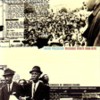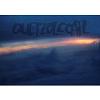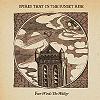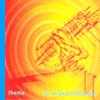- Administrator
- Albums and Singles
Robert Hampson/Steven Hess:
"S/T"
CD

A sensible combination, brought to light by a chance contact resulting in a fairly lengthy process of recording, listening, and mixing. Robert Hampson, is, of course, the visionary behind sound behemoths LOOP and MAIN, and even served a highly productive position within GODFLESH, ORGANUM, and also collaborated with JIM O' ROURKE. Steven Hess is a percussionist who provides comfortably obscure rhythms and textures for PAN AMERICAN, FESSENDEN, ON, and HAPTIC.
Together, Hampson and Hess create a delightful peephole into the space where resonance from various percussions exist. These are the indirect moments that are just as real as those obvious times when a drummer nails the snare drum in 4/4 time. This is the stuff that for without, the attack, the beat, the percussion itself, would be lifeless pricks of meaningless sound. These recordings are filled with the active and excited ghost of interaction with material; highly unreal at times, and undeniably human at others. For those familiar with their previous endeavors, this is certain to please. For others, you are about to hear the collaboration of two people who know exactly what they are doing, and have created an even more powerful joined effort. Clearly tasty.
CDep released in an edition of 500, packaged in mulitple layers of clear material. See?
Available online from Crouton directly: http://www.croutonmusic.com/cr31.htm
Read More
- Administrator
- Albums and Singles
 The new album from Ben Reynolds is almost more of a collection of alien beeps, hums, chimes, and drones than actual songs since there’s little melodic interplay between these elements. As an interpretation of the cosmos, however, it succeeds splendidly.
The new album from Ben Reynolds is almost more of a collection of alien beeps, hums, chimes, and drones than actual songs since there’s little melodic interplay between these elements. As an interpretation of the cosmos, however, it succeeds splendidly.
A sad little melody does creep under outer space transmissions, as if two passing space ships are talking back and forth, on “Unmighty Plumes of to Moon Shit” while “Telecopter Ordinary Century” is like attending church on another planet with its stately organ. “Sweet Misty” features strange voices as well as bloops that could be from electronic music’s infancy. A crew repairs a space station on “Havoc Yawk” between bouts spent fending off enemies who blast lasers in a battle of some unknown war. Apart from the constant machinery pulse which goes on for too long, I like the rest of “Classic at the Sound World” with its gentle tones and skittering almost-melodies.
One of the album’s weak spots is that although it’s generally ambient by nature, the tracks are atmospheric in mostly the same way, with only subtle variations from song to song. In this sense, it’s excellent background music while exploring outer space, but it’s a little too fleeting at times to give it prolonged earthbound attention.
samples:
Read More
- Administrator
- Albums and Singles
 The fourth Henri Pousseur CD in Sub Rosa’s Early Electronics series features two long works. Although his condensation of his own interpretation of the Faust legend has been heard infrequently, this is the premiere of "Crosses of Crossed Colors" and to me is the more intriguing and powerful of the two.
The fourth Henri Pousseur CD in Sub Rosa’s Early Electronics series features two long works. Although his condensation of his own interpretation of the Faust legend has been heard infrequently, this is the premiere of "Crosses of Crossed Colors" and to me is the more intriguing and powerful of the two.
The three movements of "Crosses of Crossed Colors" employ two pianos as well as turntable and tape machine operators who all support highly-accoladed solo vocalist Joy Blackett. Pousseur, who believes in open works that allow for improvisation, uses Blackett in the call and response gospel style that was central to the development of jazz and blues. Blackett uses her powerful, incantatory voice primarily to recite variations of a speech given by 19th Century Native American leader Chief Seattle, which emphasizes the sanctity not only of all men, but also the very land on which they live. After each of Blackett’s statements, the other musicians answer with piano phrases; radio snippets of news programs, conversations, and popular music; and record excerpts of operatic notes and indigenous music. Blackett links Chief Seattle’s sentiments to the Civil Rights Movement of the 20th Century to stirring effect. Not only is Blackett’s performance moving, it’s also particularly relevant even today to the problems of racism faced in the aftermath of Katrina and to the ecological emergency the planet faces as its resources are obliterated at an astonishing rate. If anything, the persistence of these issues highlights how important they remain.
In contrast, any issues are handled obliquely in "Jeu de Miroirs de Votre Faust," which is basically a tape collage "diary" of a previous performance of Pousseur’s original composition, mixing its themes, lyrics, and even syllables into a non-linear, fragmented version of the original. The result is mostly enjoyable, though I must admit that I would have gotten more out of it were my French better. Still, its construction alone is fascinating enough to make the recording compelling.
Although both pieces have structural similarities, Blackett’s performance alone makes "Crosses of Crossed Colors" the highlight, and the opus might one day be considered one of Pousseur’s best works.
samples:
- Crosses of Crossed Colors, Part One
- Crosses of Crossed Colors, Part Three
- Jeu de Miroirs of Votre Faust
 
Read More
- Administrator
- Albums and Singles
 Queztolcoatl is the one man noise project of Dublin’s Timothy. All of the releases I’ve listened to from his label, Haunted Tape, are heavily indebted to anything and everything on the similarly named American Tapes run by Wolf Eyes. This holds true for The Eternal Electrical Flesh Storm. Much of the hour or so of audio could be culled from anyone of the many lacklustre Wolf Eyes releases. It sounds to me like noise done for the sake of boredom.
Queztolcoatl is the one man noise project of Dublin’s Timothy. All of the releases I’ve listened to from his label, Haunted Tape, are heavily indebted to anything and everything on the similarly named American Tapes run by Wolf Eyes. This holds true for The Eternal Electrical Flesh Storm. Much of the hour or so of audio could be culled from anyone of the many lacklustre Wolf Eyes releases. It sounds to me like noise done for the sake of boredom.
There is not much here to make me sit up and pay attention. Layers of looped and heavily distorted screaming combined with swathes of feedback are the central components of the album. However there is little creativity or innovation. The tracklisting is on a small scrap of paper with a font that is very American Tapes-ish, again this aping of Wolf Eyes is pretty dull and frustrating to try and read. The painted CD-R equally makes me want to shake Hurley and ask him to please, please, please consider finding some more influences.
The opener, “Wild Spiral,” is a mediocre and inoffensive attempt at noise. Noise should be vibrant and all consuming, not easily ignorable and lifeless. The production is pretty poor. While I “get” that DIY noise with cheap equipment is hip and very much in this season, it still sounds piss weak. All of the pieces are thin and tinny sounding. There is no oomph to them. I know Hurley has the ability to make a thick wall of sound as I’ve experienced one of his other projects live and I enjoyed it immensely. Quetzolcoatl did not live up to my expectations at all. Only occasionally does the noise expand to become even remotely gripping, segments in “Lost Forest Vanishing to Nowhere” and “Dead at Sea/Lost Lights” piqued my interest. Apart from these brief moments The Eternal Electrical Flesh Storm is background noise, not the type of noise Hurley was aiming for I’m guessing.
The CD-R and cheap audio equipment culture has allowed some gems to make it out into the real world that would otherwise never be heard. On the flipside, it has also allowed thousands of average (and worse) music to get out further than they should. The Eternal Electrical Flesh Storm is a prime example of a lack of quality control, not enough artists take the time to work out an album or even an EP as much as they should.
samples:
Read More
- Administrator
- Albums and Singles
 This is a psychedelic folk four piece that from Chicago who combine a fin de siècle chamber style similar to Rasputina but stripped of any rock and pop pretensions. Blended with eastern tones and rhythms the result is a spectacular album.
This is a psychedelic folk four piece that from Chicago who combine a fin de siècle chamber style similar to Rasputina but stripped of any rock and pop pretensions. Blended with eastern tones and rhythms the result is a spectacular album.
The music is complex and ornate. Frequently the four ladies seem to be playing four different but complementary songs, such as “Sheye” which is hypnotic and primal. At times it threatens to fall apart but the intensity of the piece keeps it together. This breaks into the far more sedate but equally intense “Sort Sands.” Here the eastern influences come to the fore and the music brings to mind images of a desolate and beautiful desert. The vocals are scorching hot and sexy. It reminds me of Dead Can Dance if Dead Can Dance were actually any good. There is also sometimes an almost queasy quality to the music like on “Born in a Room,” it is disorientating and not something I can listen to with a couple of drinks on me.
The first couple of times I listened to Four Winds the Walker I found some of the vocals tough going. At times the ladies (they take turns with singing) sound bored disinterested, such as on “Serum,” the definite low point of the album. Other times the vocals were grating on the ears but once I accepted their vocal styles and realised it wasn’t just bad singing, it clicked with the music nicely. “Imaginary Skin” contains some fantastic surreal lyrics: “So will she go beyond the minds with all their mazes?/ Mazes that lead through finds with all their faces?” Doesn’t look as great on paper granted but believe me, it’s wonderful on disc.
I was recommended to listen to Four Winds the Walker by a friend and next time I see him I owe him a pint. It is an absolute corker of an album. It definitely improves every time I listen to it, there is so much intricacy in the playing and vocals that every time there is a new element revealed or an audio path to follow through the album. It is an album rich in detail that I could immerse myself in for days on end.
samples:
Read More
- Gary Suarez
- Albums and Singles
Their tightly produced beats and futuristically urban atmospheres are marred by an unfortunate selection of mostly lackluster emcees like Rqm and Maxx, whose respective flows recall everything I hate about "indie" hip hop. Exceptions to this rule are Ras T-Weed's sublime and subdued delivery on the jagged "Blessed" and "Corridors of Power," the latter featuring Neonman doing his best Shaun Ryder impression over a funktastic bassline and speaker rumbling beat. Rider Shafique's notable input on "Rising Tides" nearly distracts from the aforementioned Rqm's unimpressive contribution to this otherwise well executed darkly dubby dancehall cut. I would've probably enjoyed this album far more had Tolcha taken the Jamaican ascetic aesthetic to heart and rinsed most if not all of the vocals from the mix. Perhaps an instrumental version is in order.
Read More
- Administrator
- Albums and Singles
 For their second album, this trio utilizes traditional and exotic instruments that are refocused digitally into airy, minimalistic atmospheres with a quasi-mystical vibe that's geared more toward darkness than enlightenment.
For their second album, this trio utilizes traditional and exotic instruments that are refocused digitally into airy, minimalistic atmospheres with a quasi-mystical vibe that's geared more toward darkness than enlightenment.
The production quality is impeccable, yet this gives the music a glassy sheen that keeps it from becoming intimate. For me, songs like "Jisatsu" and "A Few Words Failed" are too cold and clinical to be used for meditative purposes, and too unsettling to be relegated to the background. Things do warm up a bit with the chanting that appears on "East of Now," accompanying instruments that finally reveal their organic origin, but this track almost seems at cross-purposes to what transpires previously. The end of "Our Angels Orbit Future Places" contains a forlorn piano and children's voices that bring out a humanity previously absent, something the group could have explored further.
Much of the material seems to lack something, like vocals or some sort of visual element, but I can see how performed live this really wouldn't be as much of an issue with the proper setting and context. Too many of their sounds, not to mention the mythology they invoke, remind me of Coil, which isn't too great of a leap considering Sion Organ mastered the album, but they do suffer in comparison. Even if not a whole lot of new ground is broken here, they create decent dark ambience, I only wish that there were more things to encounter in the shadows.
samples:
Read More
- Administrator
- Albums and Singles
 Inspired by the low-volume, "marginal" sounds that make up the unconscious bed music of urban living, Paiuk creates a tape collage of musique concrète for the microsound/lowercase generation.
Inspired by the low-volume, "marginal" sounds that make up the unconscious bed music of urban living, Paiuk creates a tape collage of musique concrète for the microsound/lowercase generation.
Res Extensa isolates the small sounds of mechanical interference occurring for most people daily, from toaster-hum and PC-error to the faraway rumble of aircraft. His goal is not so much broad re-contextualization, but, as the title might suggest, a kind of extension past individual association towards the creation of what he calls "a sensitive whole," where sounds are "exposed in their affective characters and our connections to them." A bit cryptic in his desires, Paiuk is asking for something more than what a standard concrète composer would: not that the toaster be recognized as a familiar word within an unfamiliar sentence structure (and all of the old associations that this new placing carries over or leaves behind), but that the toaster be semi-recognized as maybe-a-toaster-as-I-know-it but also maybe this or that device or field of audible energy that I interface with enough that it does not feel alarming in juxtaposition.
The layered construction of Res Extensa suggests that sounds be left to flail and mingle in an interzone between immediate, "physical" reaction and direct cognitive interpretation. For me, the appeal of microsound or lowercase music or related things like The Conet Project has always worked on a similar level: the fusing of fields of small, not-immediately-jarring noise interferences (or the "glitch"-opposite: forced interferance of silence or faulty connection) to a level of dynamism and nuance where listening is less geared towards a 'picking-out' of sounds or the tracking of particular extremes but to the establishment of a kind-of limbo state, a suspension among past-recognizable forces seen now as more forces or fields of energy than anything solid.
The Conet Project dramatizes this idea by isolating literal phantom frequencies, radio energy with indirect aim and obscured potential. In comparison, Paiuk’s piece is a more comforting and relatively lush soundworld, its spaces small and inviting and its pace a slow unraveling of disturbances that never trump each other. Paiuk seems to imply that any overt drama in Rec Extensa comes from projected sources, and in this sense, the piece is some most unlikely ‘body music’ existing, as it tries to, in the realm of the senses with a barrier (however slightly or necessarily permeable) against all that might allow these sounds to fade into meaning.
samples:
Read More
- Administrator
- Albums and Singles
 Although Peter Wright is a talented musician who produces evocative drones, what separates his music on this album from others exploring similar territory are the field recordings underlying the mix which provide a narrative of sorts. If they don't add up to one grand tale, then it is these pockets of stories scattered throughout the album that lend it an emotional core.
Although Peter Wright is a talented musician who produces evocative drones, what separates his music on this album from others exploring similar territory are the field recordings underlying the mix which provide a narrative of sorts. If they don't add up to one grand tale, then it is these pockets of stories scattered throughout the album that lend it an emotional core.
For instance, when "Approaching Low from the West" becomes a high-pitched wail drowning all voices but its own, it's capped by a billowing cloud that disintegrates all that has come before. Combined with an ominous guitar on "Blue Ridge," the water and the boat slapping against a dock suggest an empty aftermath that mutates into the shouts, helicopters, and sly marching drum of the title track.
Field recordings aren't evident in every song, and sometimes the music alone must carry the narrative, if there is one. For me, these spots are a lull in the album, but perhaps a necessary sanctuary. It's not until a banshee tunnel becomes a gentle guitar and birdsong in "Cows" that a new morning seems possible. The journey ends bittersweet with "Infection" as ringing stars and Doppler memories preface an elderly woman recounting her troubles walking which, it turns out, is because of a chest infection. I'm not sure what this story of hers has to do with the album as a whole other than emphasizing life's frailty, but the sentiment itself is clear.
With a guitar, effects, and carefully chosen recordings, Wright has created an album of surprising beauty.
samples:
Read More
- Administrator
- Albums and Singles
 Daniel Burton recruits a talented cast, including members of Black Mountain and Windsor for the Derby, to expand a track from 2002’s Let Us Garlands Bring into a touching suite of songs surrounded by emotionally charged instrumentals.
Daniel Burton recruits a talented cast, including members of Black Mountain and Windsor for the Derby, to expand a track from 2002’s Let Us Garlands Bring into a touching suite of songs surrounded by emotionally charged instrumentals.
The music itself is lush with reverb as several layers of guitars swim together rather than fight for dominance. Like comets or other celestial bodies, gentle feedback lends qualities of longing and melancholy that complement the other instruments and the vocals without stealing attention.
Beginning with “Deserter,” the core features three songs with lyrics lamenting narcissism, apathy, and the dissolution of responsibility. Generous cross-fading links them as much as the subtle melodic shifts that transform into new songs, weaving them together so tightly that each one would lose something were it to be separated from the others. The voices of Burton himself, Kate Long, and Amber Webber are all able to handle the weight of the music and maintain the same level of levity. Webber’s “Return of the Native” is especially frail, with a tender vulnerability that underscores lyrics such as, “Losing you to your desire/In rooms with ocean views.” The instrumentals are propulsive, wrapping the suite in an urgency and importance that give weight to the revelations within.
In its evocation of yearning landscapes and spiritual exhaustion, Offshore is the perfect complement to summer nights.
samples:
Read More
- Administrator
- Albums and Singles
 To celebrate a quarter century of great compilations and albums by many exciting artists, Touch have released this new compilation. 25 exclusive tracks featuring most of Touch’s luminaries sum up both Touch’s history and mission perfectly while at the same time showing that Touch still know how to make a great compilation (an art that is neglected by nearly every other label).
To celebrate a quarter century of great compilations and albums by many exciting artists, Touch have released this new compilation. 25 exclusive tracks featuring most of Touch’s luminaries sum up both Touch’s history and mission perfectly while at the same time showing that Touch still know how to make a great compilation (an art that is neglected by nearly every other label).
Touch
The disc is presented in a digipack with an included that contains lots of beautiful photos by label head/graphic designer Jon Wozencroft. Some of these have been included in previous releases on the label but it’s nice to see them again. Wozencroft also contributes a number of short field recordings ranging from a recording of an air captain’s announcement before landing to plumbing to a myriad of noises I cannot identify (the liner notes are non-existent for these recordings). These brief vignettes clear the aural palate between the meatier contributions.
Staying with field recordings, Chris Watson has provided two pieces to Touch 25. Unusually for Watson, these two pieces are fairly pedestrian (no, not recordings of people walking). Neither piece holds my attention for long which is especially unfortunate as both of them are less than three minutes each. The aforementioned recordings by Wozencroft have more vitality to them. As does Jacob Kirkegaard’s “Heavy Water [Bärseback],” a recording of water from a nuclear plant’s cooling system which captures the power and menace associated with splitting atoms.
Oren Ambarchi’s “Moving Violation” is one of my fave pieces on the album. The looped guitar hum and drone shows how much he has contributed to Sunn O)))’s last album. In fact, without the riffing Ambarchi’s guitar playing sounds more threatening. In stark contrast to Ambarchi is “Tree” by Fennesz which follows immediately. His acoustic guitar playing is warm and delicate; soft electronics smooth the edges of his playing. The difference between these two artists highlights the range of artists that Touch has championed over the years.
The jewel that shines more than any other on Touch 25 is Jóhann Jóhnannssonn’s “Tu Non Mi Perderai Mai.” It is haunting, beautiful and transcendental. I keep coming back to this particular piece to play and play again. Although the liner notes state that it is just two instruments (a ring modulated Hammond organ and a cello) it sounds like there are a host of synthesisers and sequencers at work. The natural sounding cello sounds almost unnatural with the celestial Hammond sounding like it’s going into orbit.
Not surprisingly but still disappointingly is the complete absence of material by The Hafler Trio considering Andrew McKenzie was such a central part of Touch for so many years. As such I find it quite odd, despite whatever differences there are between them, that McKenzie is not at least mentioned somewhere on a compilation celebrating the past, present and future of Touch.
Aside from that Touch 25 is a wonderful compilation, few compilers show as much quality control as the folks at Touch have. Unlike the vast majority of compilations, this disc runs smoothly like a good album by a single artist. Considering the scope of artists and styles appearing on Touch 25, this is some feat.
samples:
- Fennesz - Tree
- Jóhann Jóhannsson - Tu Non Mi Perderai Mai
- Philip Jeck - Hindquarters
Read More

